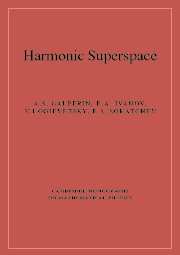Book contents
- Frontmatter
- Contents
- Preface
- 1 Introductory overview
- 2 Elements of supersymmetry
- 3 Superspace
- 4 Harmonic analysis
- 5 N = 2 matter with infinite sets of auxiliary fields
- 6 N = 2 matter multiplets with a finite number of auxiliary fields. N = 2 duality transformations
- 7 Supersymmetric Yang–Mills theories
- 8 Harmonic supergraphs
- 9 Conformal invariance in N = 2 harmonic superspace
- 10 Supergravity
- 11 Hyper-Kähler geometry in harmonic space
- 12 N = 3 supersymmetric Yang–Mills theory
- 13 Conclusions
- Appendix: Notations, conventions and useful formulas
- References
- Index
6 - N = 2 matter multiplets with a finite number of auxiliary fields. N = 2 duality transformations
Published online by Cambridge University Press: 24 August 2009
- Frontmatter
- Contents
- Preface
- 1 Introductory overview
- 2 Elements of supersymmetry
- 3 Superspace
- 4 Harmonic analysis
- 5 N = 2 matter with infinite sets of auxiliary fields
- 6 N = 2 matter multiplets with a finite number of auxiliary fields. N = 2 duality transformations
- 7 Supersymmetric Yang–Mills theories
- 8 Harmonic supergraphs
- 9 Conformal invariance in N = 2 harmonic superspace
- 10 Supergravity
- 11 Hyper-Kähler geometry in harmonic space
- 12 N = 3 supersymmetric Yang–Mills theory
- 13 Conclusions
- Appendix: Notations, conventions and useful formulas
- References
- Index
Summary
In this chapter we demonstrate that all known off-shell N = 2 matter multiplets with finite sets of auxiliary fields are described by Grassmann analytic superfields with properly chosen harmonic constraints. We define the N = 2 superfield duality transformation and use it to show explicitly that the general self-couplings of these constrained N = 2 matter superfields are reduced to particular classes of the q+ hypermultiplet self-coupling.
Introductory remarks
As was mentioned in Section 5.1.4, before the invention of harmonic superspace N = 2 off-shell matter had been described by constrained superfields in ordinary N = 2 superspace. These are the N = 2 tensor multiplet [D19, S6, W6], non-linear multiplet [D16, D17], relaxed hypermultiplet [H15] and its generalizations [Y1], etc. Since such superfields have finite sets of components, they are sometimes easier to deal with than the unconstrained Grassmann analytic superfields, e.g., when constructing physical component actions. However, they are certainly not adequate for describing the most general N = 2 matter action and, respectively, the most general set of hyper-Kähler metrics. The natural object representing N = 2 off-shell matter is the Grassmann analytic superfield q+. Only with its help one can establish a one-to-one correspondence between N = 2 matter and hyper-Kähler manifolds.
- Type
- Chapter
- Information
- Harmonic Superspace , pp. 107 - 127Publisher: Cambridge University PressPrint publication year: 2001



